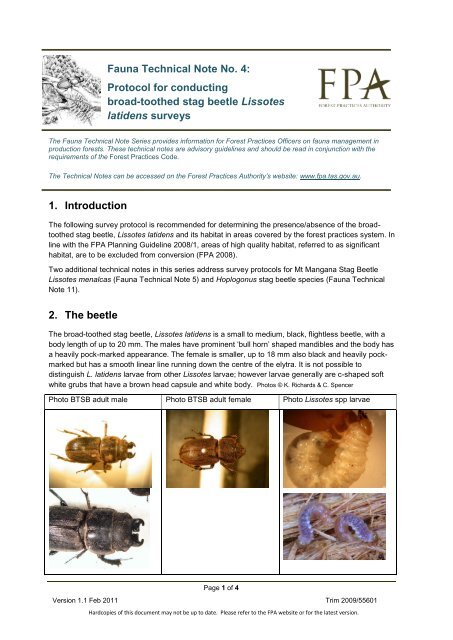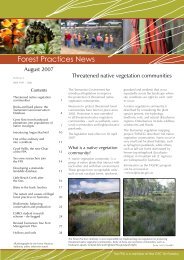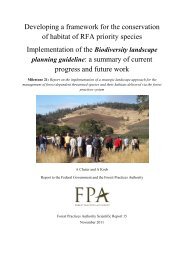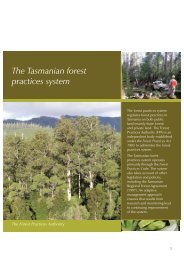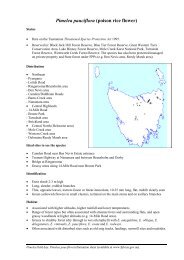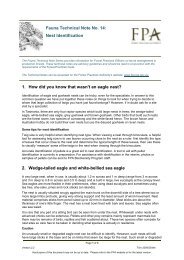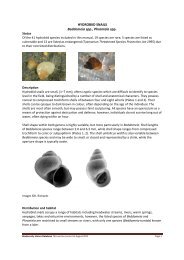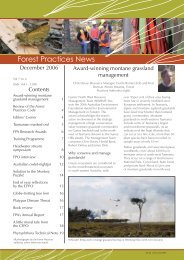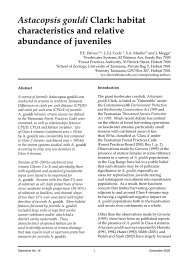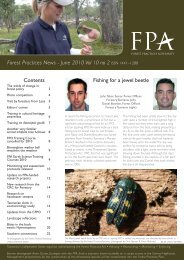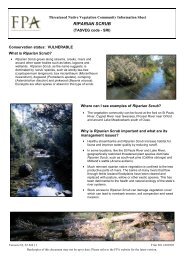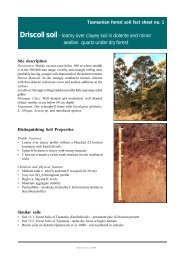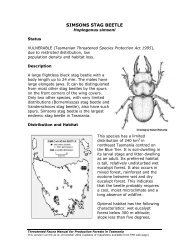Broad-toothed stag beetle survey protocol - The Forest Practices ...
Broad-toothed stag beetle survey protocol - The Forest Practices ...
Broad-toothed stag beetle survey protocol - The Forest Practices ...
You also want an ePaper? Increase the reach of your titles
YUMPU automatically turns print PDFs into web optimized ePapers that Google loves.
Fauna Technical Note No. 4:Protocol for conductingbroad-<strong>toothed</strong> <strong>stag</strong> <strong>beetle</strong> Lissoteslatidens <strong>survey</strong>s<strong>The</strong> Fauna Technical Note Series provides information for <strong>Forest</strong> <strong>Practices</strong> Officers on fauna management inproduction forests. <strong>The</strong>se technical notes are advisory guidelines and should be read in conjunction with therequirements of the <strong>Forest</strong> <strong>Practices</strong> Code.<strong>The</strong> Technical Notes can be accessed on the <strong>Forest</strong> <strong>Practices</strong> Authority’s website: www.fpa.tas.gov.au.1. Introduction<strong>The</strong> following <strong>survey</strong> <strong>protocol</strong> is recommended for determining the presence/absence of the broad<strong>toothed</strong><strong>stag</strong> <strong>beetle</strong>, Lissotes latidens and its habitat in areas covered by the forest practices system. Inline with the FPA Planning Guideline 2008/1, areas of high quality habitat, referred to as significanthabitat, are to be excluded from conversion (FPA 2008).Two additional technical notes in this series address <strong>survey</strong> <strong>protocol</strong>s for Mt Mangana Stag BeetleLissotes menalcas (Fauna Technical Note 5) and Hoplogonus <strong>stag</strong> <strong>beetle</strong> species (Fauna TechnicalNote 11).2. <strong>The</strong> <strong>beetle</strong><strong>The</strong> broad-<strong>toothed</strong> <strong>stag</strong> <strong>beetle</strong>, Lissotes latidens is a small to medium, black, flightless <strong>beetle</strong>, with abody length of up to 20 mm. <strong>The</strong> males have prominent ‘bull horn’ shaped mandibles and the body hasa heavily pock-marked appearance. <strong>The</strong> female is smaller, up to 18 mm also black and heavily pockmarkedbut has a smooth linear line running down the centre of the elytra. It is not possible todistinguish L. latidens larvae from other Lissotes larvae; however larvae generally are c-shaped softwhite grubs that have a brown head capsule and white body. Photos © K. Richards & C. SpencerPhoto BTSB adult male Photo BTSB adult female Photo Lissotes spp larvaePage 1 of 4Version 1.1 Feb 2011 Trim 2009/55601Hardcopies of this document may not be up to date. Please refer to the FPA website or for the latest version.
Fauna Technical Note No. 4 Protocol for conducting broad-<strong>toothed</strong> <strong>stag</strong> <strong>beetle</strong> Lissotes latidens <strong>survey</strong>sAs a threatened species, no attempts should be made to search or collect the <strong>beetle</strong>, unless permittedto do so under a current Threatened species permit issued by the Threatened Species Section,DPIPWE.3. <strong>Broad</strong>-<strong>toothed</strong> <strong>stag</strong> <strong>beetle</strong> habitat assessment<strong>The</strong> broad-<strong>toothed</strong> <strong>stag</strong> <strong>beetle</strong> occurs across a range of forest types, including wet eucalypt, mixedforest and rainforest, and can also be found in creek and drainage depressions in dry forest. It livesbeneath logs and woody debris and display a preference for wood of a size >10 cm in diameter that hasgood soil contact. No preference for wood from any particular species has been recorded.Research work conducted by Meggs (Meggs 1999; Meggs & Munks 2003), and Richards and Spencer(Richards et al 2006) has identified a set of habitat characteristics which can broadly be used to assessthe quality of L. latidens <strong>stag</strong> <strong>beetle</strong> habitat. In summary, <strong>survey</strong>s indicate that the species prefers areasthat:occur beneath a well developed canopycontain a high abundance of coarse woody debris (logs occupy > 10% of the forestfloor)contain patches of damp or wet forest within dry eucalypt forest, especially drainagelines and wet gullies, or wet eucalypt forest and rainforest.At this <strong>stag</strong>e, areas of high quality habitat cannot be mapped, and so <strong>survey</strong>s are needed to informwhere these areas occur.Where should a habitat assessment be conducted?Habitat assessments should be conducted in any proposed coupe/development within the range of thebroad-<strong>toothed</strong> <strong>stag</strong> <strong>beetle</strong> (see Fauna Values Database or Natural Values Database) to assist withapplication of current agreed management recommendations delivered by the FPA threatened speciesplanning tools (e.g. Threatened Fauna Adviser, FPA Planning Guideline 2008/1).Habitat <strong>survey</strong> methodA site visit is necessary to identify areas of potential habitat (damp or wet forest and rainforest) withinthe operation area. <strong>The</strong>se areas must be identified on the planning map.4. <strong>Broad</strong>-<strong>toothed</strong> <strong>stag</strong> <strong>beetle</strong> <strong>survey</strong>sConfirmation of the presence/absence of the <strong>beetle</strong> is required for some operations.Beetle <strong>survey</strong> method<strong>The</strong> presence of adult <strong>beetle</strong>s may be determined by employing a single search method involving thesystematic rolling of logs and smaller woody debris to enable close scrutiny of the exposed ground forthe presence of live adults and exoskeletal remains.How many sites should be <strong>survey</strong>ed?<strong>The</strong> <strong>survey</strong> points should be stratified across the coupe, with a minimum of one <strong>survey</strong> point perPage 2 of 4Version 1.1 Feb 2011 Trim 2009/55601Hardcopies of this document may not be up to date. Please refer to the FPA website or for the latest version.
Fauna Technical Note No. 4 Protocol for conducting broad-<strong>toothed</strong> <strong>stag</strong> <strong>beetle</strong> Lissotes latidens <strong>survey</strong>s10 hectare area, with a maximum of three per 10 ha. This will depend on the variability of forest typeswithin the coupe, whereby a <strong>survey</strong> point should be conducted in each different forest type. <strong>The</strong> locationof each <strong>survey</strong> point is to be marked on an accompanying coupe map.How to conduct the <strong>survey</strong>?Each <strong>survey</strong> point should consist of a circle of 30 m in diameter, inside which all moveable woody debrisshould be sampled.What to record?site number and location (marked on map)GPS co ordinatesproximity to stream or other drainage featurediameter of wood where <strong>beetle</strong>s are locatednumber of <strong>beetle</strong>s (live male, dead male, other)digital macro images of <strong>beetle</strong>s.ReferencesFPA Planning Guideline 2008/1 2008, An internal planning framework developed by the <strong>Forest</strong> <strong>Practices</strong> Authorityfor the purposes of delivering management prescriptions through the Threatened Fauna Adviser to avoid or limitthe clearance and conversion of significant habitat for threatened forest fauna, <strong>Forest</strong> <strong>Practices</strong> Authority,Hobart, Tasmania.Meggs, JM and Munks, SA 2003, Distribution, habitat characteristics and conservation requirements of a forestdependentInvertebrate Lissotes latidens (Coleoptera: Lucanidae), Journal of Insect Conservation 7: 137–152.Meggs, JM 1999, Surveys for Lissotes latidens (<strong>Broad</strong>-<strong>toothed</strong> <strong>stag</strong> <strong>beetle</strong>) in priority coupes on the <strong>Forest</strong>ier andTasman Peninsulas, Report to <strong>Forest</strong>ry Tasmania and the <strong>Forest</strong> <strong>Practices</strong> Board.Meggs, JM 1999, Distribution, habitat characteristics and conservation requirements of the <strong>Broad</strong>-<strong>toothed</strong> <strong>stag</strong><strong>beetle</strong> Lissotes latidens (Coleoptera: Lucanidae), A report to the <strong>Forest</strong> <strong>Practices</strong> Board and <strong>Forest</strong>ry Tasmania.Richards, K, Munks, SA, Spencer, C and Wapstra, M 2006, ‘Monitoring the effectiveness of conservation measuresfor the broad-<strong>toothed</strong> <strong>stag</strong> <strong>beetle</strong>, Lissotes latidens, in south-east Tasmania, June 2006’, <strong>Forest</strong> <strong>Practices</strong>Authority Scientific Report No. 3, <strong>Forest</strong> <strong>Practices</strong> Authority, Hobart.Publication detailsThis technical note has been prepared by Karen Richards (FPA). It should be cited as:<strong>Forest</strong> <strong>Practices</strong> Authority 2010, ‘Protocol for conducting <strong>Broad</strong>-<strong>toothed</strong> Stag Beetle Lissotes latidens<strong>survey</strong>s’, Fauna Technical Note No. 4, <strong>Forest</strong> <strong>Practices</strong> Authority, Hobart.(FPA reference FPA/07/307/002 Record 2009/55601)Contact details<strong>Forest</strong> <strong>Practices</strong> Authority: 30 Patrick Street, Hobart, Tasmania 7000.Phone: (03) 6233 7966Fax: (03) 6233 7954; Email: info@fpa.tas.gov.au; Website: www.fpa.tas.gov.auPage 3 of 4Version 1.1 Feb 2011 Trim 2009/55601Hardcopies of this document may not be up to date. Please refer to the FPA website or for the latest version.
Fauna Technical Note No. 4 Protocol for conducting broad-<strong>toothed</strong> <strong>stag</strong> <strong>beetle</strong> Lissotes latidens <strong>survey</strong>sDocument Summary InformationDocument nameVersion 1.0Trim record 2009/55601Fauna Technical Note No.4: Protocol for conducting broad-tooth <strong>stag</strong>e <strong>beetle</strong>,Lissotes latidens <strong>survey</strong>sOwnerAuthor(s)Biodiversity Section StaffBiodiversity Section StaffRelease date February 2010Release Approved byRelease statusBiodiversity ManagerFor publication on the FPA webpage and other external distributionVersion ControlVersion Date Author(s) Summary of changes1 Feb 2010 BiodiversitySection StaffDocument creation1.1 Feb 2011 Nina Roberts Note: the wording of this document is identical to that approvedby the FPA Biodiversity Manager in early 2010, except for theaddition of document control information.Page 4 of 4Version 1.1 Feb 2011 Trim 2009/55601Hardcopies of this document may not be up to date. Please refer to the FPA website or for the latest version.


